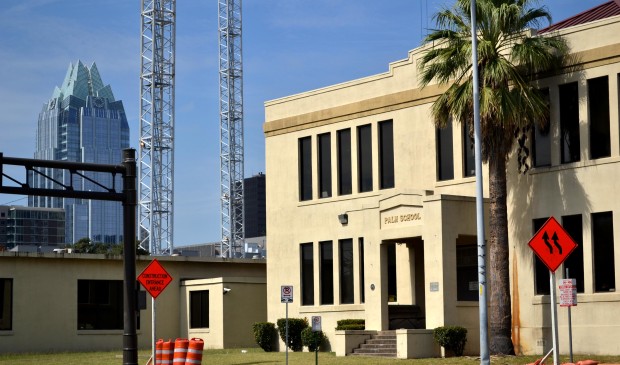Palm School survey offers ground rules for redevelopment
Friday, April 13, 2018 by
Caleb Pritchard The Travis County Commissioners Court on Thursday received a long-awaited report on the historic bona fides of the county-owned Palm School building during a briefing that offered potential redevelopment scenarios of the 19th-century downtown Austin structure.
All of those scenarios would preserve the original structure itself and see new buildings of varying sizes rise up on the northern half of the site at the northwest corner of Cesar Chavez Street and Interstate 35.
Originally built in 1892, Palm School served its eponymous function up until 1976 when the Austin Independent School District unloaded the site onto private hands. The county acquired it 10 years later and is currently using it as the headquarters of its Health and Human Services Department. However, plans to relocate that agency to a new office on Airport Boulevard have put Palm School’s fate up in the air.
With an eye toward its lucrative value, but also in recognition of its status as a cultural icon for the largely Mexican-American community surrounding it during much of its existence, the Commissioners Court approved the historical survey last summer.
“This school is really a story of growth and expansion in the school district and the city of Austin over time,” architect Laurie Limbacher of Limbacher & Godfrey told the court when explaining the various additions made to the original structure throughout the years. Two of them – one completed in 1910 and the other in 1924 – enlarged the building’s eastern and western wings and also added a new facade on the south-facing front.
1936 saw a multistory addition grow on the building’s north side, while a one-floor cafeteria extension was added in 1949.
The survey recommends four fundamental design criteria for any future work done on the site. Those include preserving everything built up to 1924, limiting any new development to the northern side of the building, maintaining a direct relationship between the school and neighboring Palm Park, and limiting as much new parking as possible to below-grade.
The three potential scenarios offered during the presentation hewed to those criteria but varied markedly in terms of scale. The first featured two separate low-rise buildings, one four stories and the other seven, straddling an entrance to the park. The second raised both buildings to seven stories, while the third envisioned the one nearest I-35 rising to 27 floors.
Travis County senior planner Mark Gilbert stressed that the scenarios are merely conceptual and “represent only the range of possibilities that occur at the site.”
“We believe the next logical step, now that this historic structures report is complete, is gathering public input, and ideally we think that would be to assist us in developing hard covenants that would govern a deed-restricted sale,” Gilbert told the court.
County Judge Sarah Eckhardt offered a glimpse of what those covenants might look like.
“We’ve talked a lot about the Commissioners Court, about the balance that we can strike and that we should strike between the market value, the historic value and the cultural value of this property,” she said. “What I would like to direct staff to explore with us is how to link those three values so that as goes the market value, so goes the cultural and historic values.”
As an example, she suggested that a higher floor area ratio could be offered in direct proportion to a larger amount of space given to any cultural space afforded in the redevelopment. Other community benefits such as office space for nonprofits or affordable housing also remain on the table.
With the rest of the court clearly amenable to the results of the survey, Eckhardt declared that the court will vote in the coming weeks to establish a stakeholder task force as well as a broader public feedback strategy. Those items will likely come before the court next month.
The Austin Monitor’s work is made possible by donations from the community. Though our reporting covers donors from time to time, we are careful to keep business and editorial efforts separate while maintaining transparency. A complete list of donors is available here, and our code of ethics is explained here.
You're a community leader
And we’re honored you look to us for serious, in-depth news. You know a strong community needs local and dedicated watchdog reporting. We’re here for you and that won’t change. Now will you take the powerful next step and support our nonprofit news organization?









